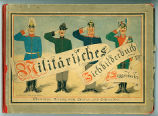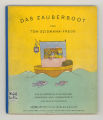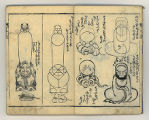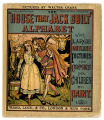Activity Books
There are a number of books that require the reader to interact with the pages and pictures by manipulating tabs, folds, slots, flaps, wheels, stencils, panoramas (or concertinas), colored cellophane or some other device to make the figures appear to "move." Some require the use of scissors, or paste or both. It is generally accepted that the first of these to be shared with children were the harlequinades or metamorphoses of Robert Sayer who began creating them in the 1770s. The French were the first to produce pages with pull-tabs and in London S. and J. Fuller's Temple of Fancy turned out a series of riches-to-rags-to-riches tales, complete with a cut-out head that could be moved from one appropriate outfit or setting to another as the tale progressed. Ingenious peep-shows were created by M. Engelbrecht in Germany where a century later the world was enchanted by the movable world of Lothar Meggendorfer. Kubasta of Czechoslovakia and Paul Faucher of Paris maintained the tradition into the 20th century. Today these masters are called "paper engineers."
 |
MILITARISCHES ZIEHBILDERBUCH by Lothar Meggendorfer. Munchen: Braun Und Schneider, n. d. |
 |
DAS ZAUBERBOOT. By Thom Seidmann-Freud. Berlin: Herbert Stuffer, 1930. |
 |
ABC PAINTING, READING. Racine, WI: A. Whitman, 1934. |
 |
DESIGNS OF ARCHITECTURAL MODELS TO BE ERECTED WITH RICHTER'S ANCHOR BLOCKS, NO. 4. Leipzig: Verlag Von Richters Verlags-Anstalt, n. d. |
 |
HOKUSAI DRAWING BOOK (ryakuga): A book on drawing by one of the world's greatest artists. The wooden blocks were created in 1812 but this printing, from the original blocks, was probably made during the Meiji period (late 19th century) based on the design of the covers and the paper used. Exhibit checklist 15.6 (View this item) |
 |
THE "HOUSE THAT JACK BUILT" ALPHABET. By Walter Crane. London and New York: Ward, Lock, and Co, [ca. 1880s]. |
 |
CHILDREN'S DRAWING BOOK by J. & P. Coats. Pawtucket, R. I.: American Works, The Coats Thread Co., n. d. |
 |
LE PETIT PAYSAGISTE: MODELES DE DESSINE, POUR DE JEUNES ENFANT, GRAVES PAR LES MEILLEURS ARTISTES. Paris: Chez Bellavoine, Libraire, [ca. 1820]. |
 |
NISTER'S PANORAMA PICTURES: A NOVEL COLOUR BOOK FOR CHILDREN. London: Ernest Nister; New York: E. P. Dutton & Co., [1890-1899]. |
 |
COUNTERS |

